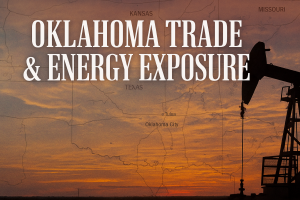Oklahoma’s Trade Landscape Examined
Oklahoma’s trade activity remains limited compared to other states, but select industries keep the state tied to the global market. That’s the focus of the latest Oklahoma Economist report from the Federal Reserve Bank of Kansas City’s Oklahoma City Branch.
The issue, titled “Oklahoma’s Trade Landscape: Broadly Insulated, Yet Exposed in Key Sectors,” explores how concentrated exports and imports could leave portions of the state economy vulnerable to global trade disruptions.
Aerospace and Energy Lead Oklahoma’s Trade Exposure
Cortney Cowley, assistant vice president and executive of the Oklahoma City Branch, said the state’s most trade-exposed sectors are aerospace and energy.
“Oklahoma’s international trade has focused on select products, particularly aerospace exports and oil imports from Canada,” Cowley said. “While Oklahoma has less exposure to international trade in aggregate, the state’s specialization in trade-heavy sectors and reliance on Canadian oil could leave pockets of the economy exposed to trade disruptions.”
The report noted that aerospace exports remain a major strength for Oklahoma, driven by aircraft manufacturing in Oklahoma City and Tulsa. However, reliance on Canadian oil imports adds risk, particularly during times of energy policy changes or global supply interruptions.
Stable but Strategic
Despite those vulnerabilities, the Fed’s report describes Oklahoma’s overall trade footprint as “broadly insulated.” The state’s diverse mix of agriculture, manufacturing, and energy keeps it relatively stable during global downturns.
Still, the concentration of certain exports could amplify the impact of a global slowdown in aerospace or energy markets.
The Oklahoma Economist concludes that policymakers and businesses should “monitor these key sectors closely” and plan for potential supply chain challenges.


